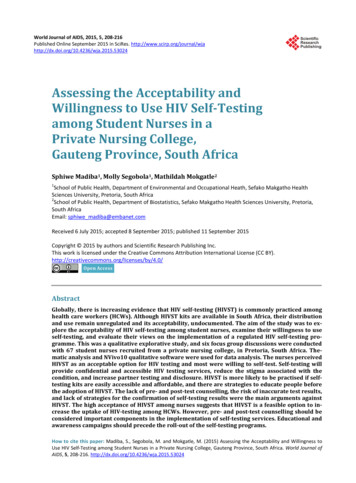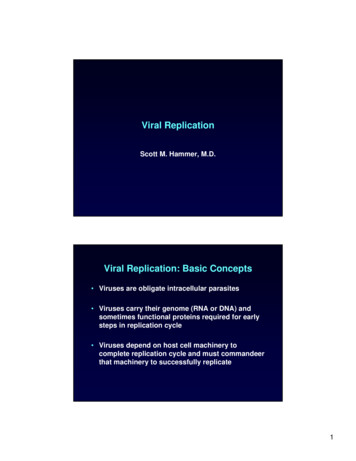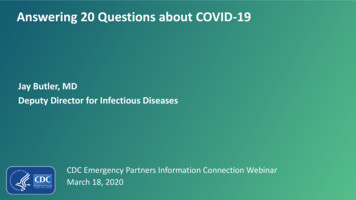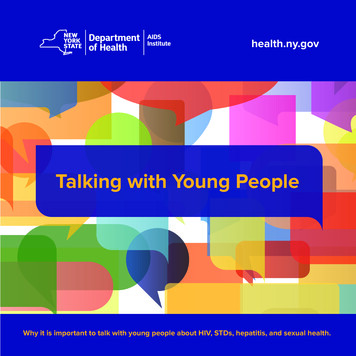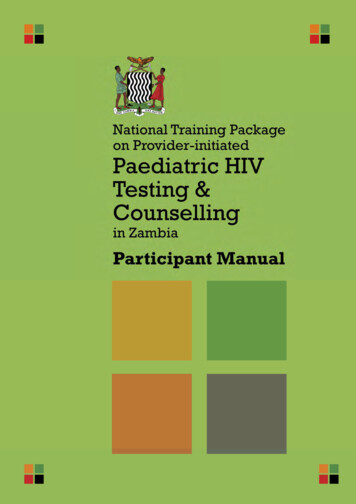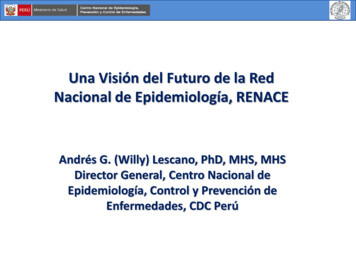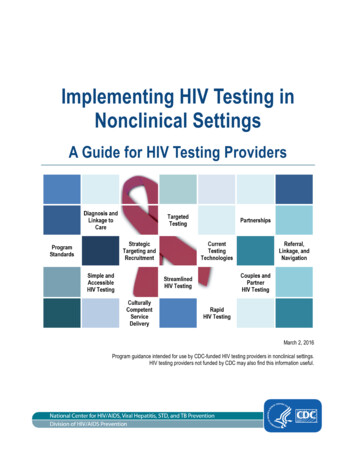
Transcription
Implementing HIV Testing inNonclinical SettingsA Guide for HIV Testing ProvidersMarch 2, 2016Program guidance intended for use by CDC-funded HIV testing providers in nonclinical settings.HIV testing providers not funded by CDC may also find this information useful.
CONTENTSAcknowledgments. 4Acronyms . 5Key Summary Points . 7Introduction . 8Purpose . 8Rationale. 8Intended Audience. 9Background . 9Vision . 11Defining Nonclinical Settings . 12Using the Guide. 13Program Principles and Standards . 14Guiding Principles . 14Ethical Standards . 15Use Best Possible Technologies and Approaches . 15Preparing the HIV Testing Environment . 15Policies and Legal Considerations . 16Provider safety. 18Quality Assurance . 19Monitoring and Evaluation. 19Targeting and Recruitment . 21Defining Targeting . 21Defining Recruitment . 22Recruitment Strategies . 22Implementing Recruitment . 24HIV Tests and Testing Strategies . 26Testing Basics . 26Testing Approaches . 28Testing Algorithms . 29ContentsHIV Testing in Nonclinical SettingsPage 2
Specimen Collection and Preparation . 31Interpreting Results . 31Delivering Test Results . 36Quality Assurance of HIV Testing . 37Conducting HIV Tests with Individuals . 38Reduced Counseling Approach . 38Steps for Conducting HIV Tests with Individuals . 38Preresults Steps . 41Postresults Steps . 43Conducting HIV Tests with Couples and Partners . 49Rationale for Testing Together . 49Benefits of Testing Together . 49Differences from Individual Testing . 50Steps for Conducting Testing Together . 50Implementing Testing Together . 52Referral, Linkage, and Navigation Services . 53Defining Referral, Linkage, and Navigation . 53Linkage Staff and Navigators. 54Implementing Referral, Linkage and Navigation Services . 54Referral, Linkage, and Navigation Strategies . 55Documenting Referrals and Monitoring Linkage . 56Conclusions . 58Chapter Summary . 58Training and Technical Assistance . 58Additional Resources . 59Thank You . 60Appendixes . 61ContentsHIV Testing in Nonclinical SettingsPage 3
ACKNOWLEDGMENTSThe Implementing HIV Testing in Nonclinical Settings: A Guide for HIV Testing Providers(herein after referred to as Implementation Guide) was created to support the implementation ofHIV testing services in nonclinical settings. The Implementation Guide was developed by theU.S. Centers for Disease Control and Prevention, Division of HIV/AIDS Prevention, CapacityBuilding Branch. Many persons supported the Capacity Building Branch and contributed to thedevelopment of this document and previous drafts of the Implementation Guide. They are listedin alphabetical order below. Qairo Ali Kristina Grabbe Jorge Alvarez Nancy Habarta Maria E. Alvarez Kathleen Irwin Jonny Andia Priya Jakhmola Ricardo Beato Kim Jenkins Lisa Belcher Rhondette Jones John Beltrami Andrea Kelly Bernard M. Branson Cindy Lyles Mari Brown Gary Marks Chezia Carraway Veronica McCants Janet Cleveland DaDera Moore Charles Collins Angel Ortiz-Ricard Jason Craw Michele Owen Kevin Delaney Amrita Patel Liz DiNenno Phil Peters Sam Dooley Miriam Phields Ted Duncan Michelle Rorie Frank Ebagua Sandra Serrano-Alicea Jacqueline Elliott Phyllis Stoll Zoe Fludd Dale Stratford Michael Friend Laura Wesolowski Lytt GardnerAcknowledgmentsHIV Testing in Nonclinical SettingsPage 4
ACRONYMSAIDSacquired immune deficiency syndromeANCantenatal careARTantiretroviral therapyARTASantiretroviral treatment and access to servicesCBAcapacity building assistanceCBOcommunity-based organizationCDCU.S. Centers for Disease Control and PreventionCHTCcouples HIV testing and counselingCLIAClinical Laboratory Improvement AmendmentsCOPcommunities of practiceCPNCBA providers networkCRISCBA Request Information SystemDISdisease intervention specialistEBIevidence-based interventionFDAFood and Drug AdministrationHAARThighly active antiretroviral therapyHCOhealth care organizationHDhealth departmentHIPhigh-impact preventionHIPAAHealth Insurance Portability and Accountability ActHIVhuman immunodeficiency virusHNSHIV navigation servicesIPVintimate partner violenceM&Emonitoring and evaluationMOAmemorandum of agreementMSMgay, bisexual, and other men who have sex with menNATnucleic acid testNHASNational HIV/AIDS StrategyNHM&ENational HIV Prevention Monitoring and EvaluationAcronymsHIV Testing in Nonclinical SettingsPage 5
nPEPnonoccupational postexposure prophylaxisOSHAOccupational Safety and Health AdministrationPEPpostexposure prophylaxisPIIpersonally identifiable informationPMTCTprevention of mother-to-child transmission of HIVPrEPpreexposure prophylaxisPSpartner servicesPWIDpersons who inject drugsQAquality assuranceQCquality controlQIquality improvementRNAribonucleic acidSNSsocial networking strategySTDsexually transmitted diseaseTAtechnical assistanceTBtuberculosisTECTraining and Events CalendarAcronymsHIV Testing in Nonclinical SettingsPage 6
KEY SUMMARY POINTS1. CDC supports 2 primary models of HIV testing—routine testing in clinical settings andtargeted testing in nonclinical settings; this Implementation Guide is intended to be used byHIV testing providers in nonclinical settings.2. HIV testing remains a critical element of the care continuum—a key goal of HIV testingservices is to diagnose HIV infection in persons who did not previously know their HIVstatus and to link them with follow-up care, treatment, and prevention services.3. Agencies should adhere to program standards, including local and state public healthpolicies and laws, to ensure they deliver high-quality HIV testing services that are culturallycompetent and linguistically appropriate.4. HIV testing in nonclinical settings should be simple, accessible, and straightforward.Minimize client barriers and focus on delivering HIV test results and on supporting clients toaccess follow-up HIV care, treatment, and prevention services as indicated.5. To reach populations at high risk for HIV infection, sites should employ strategic targetingand recruitment efforts, establish targets for key program indicators, and monitorservice delivery to ensure targeted testing is achieving program goals.6. To provide the most accurate results to clients, sites should use HIV testing technologiesthat are the most sensitive, cost-effective, and feasible for use at their agency.Establishing relationships with facilities offering laboratory-based HIV testing is importantfor referring clients who may have acute HIV infection.7. CDC no longer supports extensive pretest and posttest counseling as part of the HIVtesting event. Instead, CDC supports a streamlined model of HIV testing that includesdelivering key information, conducting the HIV test, completing brief risk screening,providing test results, and delivering referrals tailored to the client’s specific risk.8. Sites should consider offerring HIV testing services for couples or partneredrelationships to (a) attract high-risk clients who are not otherwise testing and (b) identifyHIV-discordant couples and previously undiagnosed HIV-positive clients.9. To facilitate referral and linkage, agencies should establish partnerships withorganizations that offer essential follow-up services, including clinics that offer HIV careand treatment, PrEP, and nPEP. Agencies should develop and implement protocols to helpclients navigate the health care system and access these essential services as needed.Key Summary PointsHIV Testing in Nonclinical SettingsPage 7
Chapter 1INTRODUCTIONImplementing HIV Testing in Nonclinical Settings: a Guide for HIV Testing Providers (hereafterreferred to as Implementation Guide) provides practical considerations for human immunodeficiency virus (HIV) testing in nonclinical testing sites. It is meant to be used by CDC-fundedHIV testing providers, and may also be useful for providers who are not directly funded by CDC.This Implementation Guide is intended as an orientation tool for HIV testing providers, so thatthey have one comprehensive but easy-to-read source of important information that will helpthem provide high-quality HIV testing services to their clients. Because this document isprogram guidance, and not guidelines, it was not vetted through CDC’s rigorous guidelinesdevelopment process. This document was informed by scientific evidence and best practices, andreferences relevant literature.PurposeThe purpose of this Implementation Guide is to familiarize HIV testing providers working inCDC-funded nonclinical settings with key programmatic issues and updates that impact HIVtesting service delivery. This includes, but is not limited to, reinforcing language about targetingand recruitment for HIV testing, advances in HIV testing technologies and algorithms, newprotocols for conducting HIV testing without prevention counseling, and the inclusion of couplesHIV testing. HIV testing providers who are aware of these issues are more likely to providehigh-quality HIV testing services to their clients.RationaleThe rationale for developing this Implementation Guide was to update key programmatic issuesfor HIV testing in nonclinical settings that have not been addressed since the release of RevisedGuidelines for HIV Counseling, Testing, and Referral1 in 2001. Additionally, scientific andprogrammatic advances in HIV care, treatment, and prevention warranted revisiting and updatingprevious recommendations. Some updates were included in the comprehensive Planning andImplementing HIV Testing and Linkage Programs in Non-clinical Settings: a Guide for ProgramManagers2 (hereafter referred to as Program Manager Guide). However, the Program ManagerGuide focused on planning an HIV testing program, and this Implementation Guide focuses onconducting HIV testing with clients. Therefore, the primary target audience for this document isHIV testing providers and not necessarily HIV program managers, although program managerswill also find this information useful.12CDC. Revised guidelines for HIV counseling, testing, and referral. MMWR 2001;50(RR-19):1–62.ICF Macro, Inc. Planning and implementing HIV testing and linkage programs in non-clinical settings: a guide forprogram managers. lementationGuide Final.pdf. Published 2012. Accessed May 11, 2015.HIV Testing in Nonclinical SettingsChapter 1 IntroductionPage 8
Although this Implementation Guide is consistent with many aspects of the aforementionedguidelines and Program Manager Guide (e.g., provision of voluntary, confidential HIV testing;need for obtaining informed consent; providing client-centered services; making referrals andlinkages based on test results), there are also several updates. These updates include: Addressing HIV diagnosis as the first step in the HIV care continuum Emphasizing the use of novel strategies for targeting and recruitment of high-riskpopulations, including partners of people living with HIV Discussing advances in HIV testing technologies, including new lab-based algorithms,“instant” HIV tests, and home-based self-tests Separating prevention counseling from the HIV test event and streamlining the protocolfor HIV testing Highlighting couple and partner HIV testing and counseling, or “Testing Together,” as anopportunity to ensure mutual disclosure of HIV status and improve prevention outcomes Emphasizing the importance of linking high-risk HIV-negative clients with preventionservices, including nonoccupational postexposure prophylaxis (nPEP) and preexposureprophylaxis (PrEP) Focusing on partnerships between nonclinical and clinical sites to enhance linkage forpersons living with HIV to access care and treatment within 30 days after diagnosisIntended AudienceThis Implementation Guide is intended for HIV testing providers who work in nonclinicalsettings, including any person who provides HIV testing services or oversees the provision ofHIV testing services. It is meant to be used by CDC-funded HIV testing providers and may alsobe useful for providers that are not directly funded by CDC.BackgroundCDC recommends that all adolescents and adults get tested for HIV at least once as a routine partof medical care. CDC also recommends more frequent testing (at least annually) for men who havesex with men (MSM), persons who inject drugs (PWID), and other persons at high risk for HIVinfection.1 Significant advances in HIV testing have been made since the Food and DrugAdministration (FDA) approved the first commercial HIV blood test more than 30 years ago, and itis now easier than ever to get tested for HIV. Testing technologies have improved, same-dayresults are available, testing venues are diverse and readily accessible, information about theimportance of testing is clearer and more focused on client risk factors, and testing has becomeroutine for many providers and clients. Additionally, testing is no longer something that has to bedone alone—couples and sex partners can come in and get an HIV test together, supporting oneanother with a future-focused discussion of joint risk concerns and accessing follow-up servicesbased on their test results and relationship status. The availability of antiretroviral therapy (ART)and, more recently, PrEP have provided new incentives for people to be tested, to take steps tokeep themselves and their partners healthy, and to prevent new infections.HIV Testing in Nonclinical SettingsChapter 1 IntroductionPage 9
Despite these successes, of the 1.2 million Americans estimated to be living with HIV at the endof 2012, more than 156,000 did not know their HIV status (Figure 1).3 This is significant becausemore than 30% of new HIV transmissions in the United States occur from persons who are HIVinfected but undiagnosed,4 which reinforces the importance of increasing knowledge of HIVstatus through testing and of linkage to medical care as the first step on the HIV care continuum.5Among persons whose HIV infection was diagnosed during 2013, 73% were linked to HIVmedical care within 1 month after diagnosis and 82% were linked to care within 3 months.6Retaining these persons in care, however, is a challenge; only 53.9% of persons whose HIVinfection had been diagnosed by year-end 2011 and who were alive at the end of 2012 hadreceived HIV medical care during the first 4 months of 20127 (Figure 1). HIV testing programshave made strides in strengthening linkage to HIV medical care following diagnosis, butadditional efforts are needed to reach the National HIV/AIDS Strategy for the United States(NHAS) goal of linking 85% of persons with newly diagnosed infection to HIV medical carewithin one month of diagnosis7 and to retain these persons in care. Even though linkage andretention (or reengagement in care) usually happens after HIV testing, HIV testing staff shouldbe aware of the importance of medical care for persons living with HIV infection and of theirrole in patient navigation. Presently, 61% of new transmissions occur from persons who arediagnosed but not retained in medical care; increased attention should be paid to this population.534567CDC. Monitoring selected national HIV prevention and care objectives by using HIV surveillance data—UnitedStates and 6 dependent areas—2013. HIV Surveillance Supplemental Report 2015;20(No. ance/. Published July 2015. Accessed August 19, 2015.Skarbinski J, Rosenberg E, Paz-Bailey G, et al. Human immunodeficiency virus transmission at each step of thecare continuum in the United States. JAMA Intern Med 14.8180. http://www.ncbi.nlm.nih.gov/pubmed/25706928. Accessed May 11, 2015.CDC. Understanding the HIV care continuum. http://www.cdc.gov/hiv/pdf/DHAP Continuum.pdf. PublishedDecember 2014. Accessed May 11, 2015.CDC. Monitoring selected national HIV prevention and care objectives by using HIV surveillance data—UnitedStates and 6 dependent areas—2013. HIV Surveillance Supplemental Report 2015;20(No. ance/. Published July 2015. Accessed August 19, 2015.White House Office of National AIDS Policy. National HIV/AIDS strategy for the United States: updated to2020. v-aids-strategy/nhas-update.pdf. Published July 2015.Accessed August 19, 2015.HIV Testing in Nonclinical SettingsChapter 1 IntroductionPage 10
Figure 1. Persons living with diagnosed HIV infection, 2012—Select HIV carecontinuum outcomes, United States and Puerto RicoSource: CDC. HIV care continuum for the United States and Puerto Rico.http://www.cdc.gov/hiv/pdf/Continuum Surveillance.pdf. Published July 2015. Accessed August 20, 2015.National HIV Surveillance System: Estimated number of persons aged 13 years living with diagnosedor undiagnosed HIV infection (prevalence) in the United States at the end of 2012. The estimated numberof persons with diagnosed HIV infection was calculated as part of the overall prevalence estimate.Medical Monitoring Project: Estimated number of persons aged 18 years who received HIV medicalcare during January to April of 2012, were prescribed ART, or whose most recent VL in the previous yearwas undetectable or 200 copies/mL—United States and Puerto Rico.VisionThe nation’s HIV prevention efforts are guided by the recognition that if everyone with HIV wasaware of their infection and receiving the treatment they need, HIV infections in the UnitedStates would be greatly reduced. This is a key tenet of NHAS,8 which includes several specificgoals and indicators related to early HIV diagnosis and effective care, including reducing newHIV infections, improving access to care and health outcomes, reducing HIV-related healthdisparities, and achieving a more coordinated response: 8Increase the percentage of people living with HIV who know their status to at least 90%Reduce the number of new diagnoses by at least 25%Increase the percentage of persons with newly diagnosed infection linked to HIV medicalcare within one month of their HIV diagnosis to at least 85%White House Office of National AIDS Policy. National HIV/AIDS strategy for the United States: updated to2020. v-aids-strategy/nhas-update.pdf. Published July 2015.Accessed August 19, 2015.HIV Testing in Nonclinical SettingsChapter 1 IntroductionPage 11
Increase the percentage of persons with diagnosed HIV infection who are retained inHIV medical care to at least 90%Increase the percentage of persons with diagnosed HIV infection who are virallysuppressed to at least 80%To achieve these goals, CDC and its partners are pursuing the high-impact HIV prevention(HIP) approach,9 which aims to achieve the greatest possible reductions in HIV infections byusing a combination of evidence-based, cost-effective, and scalable strategies andinterventions, such as HIV testing, linkage to HIV care for persons with newly diagnosed HIVinfection, and reengagement in care for persons diagnosed but not currently in care. Inaccordance with NHAS and the HIP approach, resources are targeted to populations andregions that are most heavily affected by HIV, where they have the greatest potential todiagnose new HIV infections, link persons with effective HIV care and prevention services,and subsequently reduce new HIV infections.Defining Nonclinical SettingsCDC supports 2 primary models of HIV testing: (1) routine testing in clinical settings, and(2) targeted testing in nonclinical settings. Although more HIV tests are conducted in clinicalsettings than in nonclinical settings, persons at high risk for HIV infection may not access healthcare services, and so it is important to utilize both strategies. This Implementation Guide isintended for the targeted testing in nonclinical settings, but may also be useful for HIV testingproviders in clinical settings.For the purposes of this Implementation Guide, nonclinical settings are sites where medical,diagnostic, and/or treatment services are not routinely provided, but where select diagnosticservices, such as HIV testing, are offered.10 Increasingly, agencies are beginning to offer clinicalservices within nonclinical settings, making this distinction a bit blurred. Still, a key feature ofnonclinical settings is their location within the community—whether at fixed venues, outreachsites, or in a person’s home, nonclinical settings are easily accessible and comfortable forpopulations who might not access medical services regularly. They typically provide same-dayrapid HIV testing, they might offer other HIV prevention services such as structural orbehavioral interventions and social services, and they conduct recruitment services to get highrisk populations in for targeted HIV testing.Examples of nonclinical settings where HIV testing may be offered include, but are not limitedto, community-based organizations (CBOs), mobile testing units, churches, bathhouses, parks,shelters, syringe services programs, health-related storefronts, homes, and other social serviceorganizations. Agencies may choose to provide HIV testing services at multiple venue types tooffer a diverse range of options, to better identify high-risk clients, and to meet the needs of thepopulations they serve.9CDC. High-impact HIV prevention: CDC’s approach to reducing HIV infections in the United States.http://www.cdc.gov/hiv/policies/hip.html. Updated April 2013. Accessed March 29, 2015.10ICF Macro, Inc. Planning and implementing HIV testing and linkage programs in non-clinical settings: a guide forprogram managers. lementationGuide Final.pdf. Published 2012. Accessed May 11, 2015.HIV Testing in Nonclinical SettingsChapter 1 IntroductionPage 12
Some health departments might be considered nonclinical settings and offer targeted HIVtesting, while others offer clinical services and routine HIV testing. Furthermore, some healthcare organizations (HCOs) might provide a blend of routine and targeted HIV testing, eventhough they are considered clinical settings. This demonstrates the complexity of distinguishingbetween clinical and nonclinical settings.Using the GuideThis guide does not supersede local or state public health policies or laws, but elements may beadapted by local or state health departments for incorporation into updated local guidance,policies, and training materials. This guide does not replace HIV testing training for new staff,but it can be used as an orientation tool for new staff or as a refresher document for existing staff.CDC-funded HIV testing providers should incorporate the concepts of this ImplementationGuide into their nonclinical HIV testing programs and may address questions about theImplementation Guide to CDC subject matter experts. CDC project officers, CBA providers, andlocal agency management may also be able to answer questions, or may be helpful in referringquestions to the appropriate subject matter experts. HIV testing providers not funded directly byCDC may also find this information useful.HIV Testing in Nonclinical SettingsChapter 1 IntroductionPage 13
Chapter 2PROGRAM PRINCIPLES AND STANDARDSHIV testing programs must strive to provide high-quality services to best meet the needs of theirclients and achieve their program objectives. There are certain principles and standards thatshould be met by all HIV testing programs in order to provide high-quality services. This chapterreviews these principles and standards, and provides links for accessing more information.Guiding PrinciplesStaff conducting HIV testing should be trained in accordance with state and local requirementsbefore providing services to clients.The following principles guide the provision of HIV testing in nonclinical settings, and HIVtesting providers should ensure that these are met:1. HIV testing is voluntary; clients have elected to be tested of their own accord, and theyare not coerced or forced to be tested. Clients have the right to decline services.2. Clients give their expressed informed consent to be tested; they clearly
Building Branch. Many persons supported the Capacity Building Branch and contributed to the . done alone—couples and sex partners can come in and get an HIV test together, supporting one another with a future-focused discussion of joint risk concerns and accessing follow-up services based on their test results and relationship status. The .

